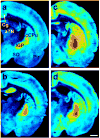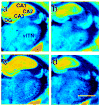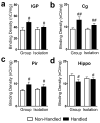Social isolation and chronic handling alter endocannabinoid signaling and behavioral reactivity to context in adult rats
- PMID: 20394803
- PMCID: PMC2882942
- DOI: 10.1016/j.neuroscience.2010.04.007
Social isolation and chronic handling alter endocannabinoid signaling and behavioral reactivity to context in adult rats
Erratum in
- Neuroscience. 2011 Jul 28;187:103
Abstract
Social deprivation in early life disrupts emotionality and attentional processes in humans. Rearing rats in isolation reproduces some of these abnormalities, which are attenuated by daily handling. However, the neurochemical mechanisms underlying these responses remain poorly understood. We hypothesized that post-weaning social isolation alters the endocannabinoid system, a neuromodulatory system that controls emotional responding. We characterized behavioral consequences of social isolation and evaluated whether handling would reverse social isolation-induced alterations in behavioral reactivity to context and the endocannabinoid system. At weaning, pups were single or group housed and concomitantly handled or not handled daily until adulthood. Rats were tested in emotionality- and attentional-sensitive behavioral assays (open field, elevated plus maze, startle and prepulse inhibition). Cannabinoid receptor densities and endocannabinoid levels were quantified in a separate group of rats. Social isolation negatively altered behavioral responding. Socially-isolated rats that were handled showed less deficits in the open field, elevated plus maze, and prepulse inhibition tests. Social isolation produced site-specific alterations (supraoptic nucleus, ventrolateral thalamus, rostral striatum) in cannabinoid receptor densities compared to group rearing. Handling altered the endocannabinoid system in neural circuitry controlling emotional expression. Handling altered endocannabinoid content (prefrontal and piriform cortices, nucleus accumbens) and cannabinoid receptor densities (lateral globus pallidus, cingulate and piriform cortices, hippocampus) in a region-specific manner. Some effects of social isolation on the endocannabinoid system were moderated by handling. Isolates were unresponsive to handling-induced increases in cannabinoid receptor densities (caudal striatum, anterior thalamus), but were sensitive to handling-induced changes in endocannabinoid content (piriform, prefrontal cortices), compared to group-reared rats. Our findings suggest alterations in the endocannabinoid system may contribute to the abnormal isolate phenotype. Handling modifies the endocannabinoid system and behavioral reactivity to context, but surmounts only some effects of social isolation. These data implicate a pivotal role for the endocannabinoid system in stress adaptation and emotionality-related disturbances.
Published by Elsevier Ltd.
Figures









Similar articles
-
Sexually-dimorphic alterations in cannabinoid receptor density depend upon prenatal/early postnatal history.Neurotoxicol Teratol. 2016 Nov-Dec;58:31-39. doi: 10.1016/j.ntt.2016.09.004. Epub 2016 Sep 12. Neurotoxicol Teratol. 2016. PMID: 27634313 Free PMC article. Review.
-
Dopamine depletion of the nucleus accumbens reverses isolation-induced deficits in prepulse inhibition in rats.Neuroscience. 2003;119(1):233-40. doi: 10.1016/s0306-4522(03)00122-2. Neuroscience. 2003. PMID: 12763084
-
Routine post-weaning handling of rats prevents isolation rearing-induced deficit in prepulse inhibition.Braz J Med Biol Res. 2005 Nov;38(11):1691-6. doi: 10.1590/s0100-879x2005001100018. Epub 2005 Oct 26. Braz J Med Biol Res. 2005. PMID: 16258640
-
Post-weaning handling attenuates isolation-rearing induced disruptions of prepulse inhibition in rats.Behav Brain Res. 2001 May;120(2):221-4. doi: 10.1016/s0166-4328(00)00374-0. Behav Brain Res. 2001. PMID: 11182170
-
The critical role of the endocannabinoid system in emotional homeostasis: avoiding excess and deficiencies.Mini Rev Med Chem. 2009 Oct;9(12):1407-15. doi: 10.2174/138955709789957468. Mini Rev Med Chem. 2009. PMID: 19929814 Review.
Cited by
-
Transcriptomic analysis of rat prefrontal cortex following chronic stress induced by social isolation - Relevance to psychiatric and neurodevelopmental illness, and implications for treatment.Neurobiol Stress. 2024 Oct 17;33:100679. doi: 10.1016/j.ynstr.2024.100679. eCollection 2024 Nov. Neurobiol Stress. 2024. PMID: 39502833 Free PMC article.
-
Sexually-dimorphic alterations in cannabinoid receptor density depend upon prenatal/early postnatal history.Neurotoxicol Teratol. 2016 Nov-Dec;58:31-39. doi: 10.1016/j.ntt.2016.09.004. Epub 2016 Sep 12. Neurotoxicol Teratol. 2016. PMID: 27634313 Free PMC article. Review.
-
Endocannabinoid system and psychiatry: in search of a neurobiological basis for detrimental and potential therapeutic effects.Front Behav Neurosci. 2011 Oct 5;5:63. doi: 10.3389/fnbeh.2011.00063. eCollection 2011. Front Behav Neurosci. 2011. PMID: 22007164 Free PMC article.
-
Corticostriatal-limbic gray matter morphology in adolescents with self-reported exposure to childhood maltreatment.Arch Pediatr Adolesc Med. 2011 Dec;165(12):1069-77. doi: 10.1001/archpediatrics.2011.565. Arch Pediatr Adolesc Med. 2011. PMID: 22147775 Free PMC article.
-
Social isolation leads to mild social recognition impairment and losses in brain cellularity.Brain Struct Funct. 2023 Dec;228(9):2051-2066. doi: 10.1007/s00429-023-02705-z. Epub 2023 Sep 10. Brain Struct Funct. 2023. PMID: 37690044
References
-
- Advani T, Hensler JG, Koek W. Effect of early rearing conditions on alcohol drinking and 5-HT1A receptor function in C57BL/6J mice. Int J Neuropsychopharmacol. 2007;10:595–607. - PubMed
-
- Andersson M, Terasmaa A, Fuxe K, Stromberg I. Subchronic haloperidol increases CB(1) receptor binding and G protein coupling in discrete regions of the basal ganglia. J Neurosci Res. 2005;82:264–272. - PubMed
-
- Bakshi VP, Geyer MA. Ontogeny of isolation rearing-induced deficits in sensorimotor gating in rats. Physiol Behav. 1999;67:385–392. - PubMed

